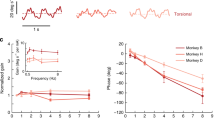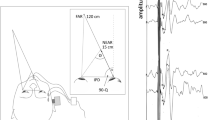Abstract
Rats are the most commonly used species in the neurosciences; however, little is known about the effects of selective electrical stimulation of individual vestibular sensors, on their eye movements. This limits their use to study the effects of vestibular stimulation on the brain, and their use in further exploring novel technologies such as artificial vestibular implants. We describe the effects of electrical stimulation of each vestibular sensor on vestibular-related eye movement in rats and compared the results to other species. We demonstrated that each sensor is responsible for specific bilateral eye movements. We found that the eye movements in rats differed from other species. Although the results were similar when stimulating the horizontal canal ampulla, differences appeared when stimulating the vertical canal sensors. During utricular stimulation, the ipsilateral eye moved dorsally in most cases, while the contralateral eye usually moved either caudally, or in extorsion. Saccular stimulation usually moved the ipsilateral eye dorsally or ventrally, while the contralateral eye usually moved ventrally or caudally. This study provides the first data on the application of selective electrical vestibular stimulation in the rat to the study of vestibular-related eye movements.






Similar content being viewed by others
Abbreviations
- AA:
-
Anterior canal ampulla
- eVOR:
-
Electrically evoked vestibulo-ocular reflex
- HA:
-
Horizontal canal ampulla
- PA:
-
Posterior canal ampulla
- SCCs:
-
Semi-circular canals
- SO:
-
Superior oblique
- VOR:
-
Vestibulo-ocular reflex
References
Brandt T, Schautzer F, Hamilton DA, Brüning R, Markowitsch HJ, Kalla R, Darlington C, Smith PF, Strupp M (2005) Vestibular loss causes hippocampal atrophy and impaired spatial memory in humans. Brain 128(Pt 11):2732–2741
Cartmill M (1974) Rethinking primate origins. Science 184(4135):436–443
Cohen BJ, Suzuki JI (1963) Eye movements induced by ampullary nerve stimulation. Am J Physiol 204(2):347–351
Cohen BJ, Suzuki JI, Bender MB (1964) Eye movements from semi-circular canal nerve stimulation in the cat. Ann Otol Rhinol Laryngol 73:153–169
Cox PG, Jeffery N (2008) Geometry of the semicircular canals and extraocular muscles in rodents, lagomorphs, felids and modern humans. J Anat 213(5):583–596
Curthoys IS (1987) Eye movements produced by utricular and saccular stimulation. Aviat Space Environ Med 58(9 Pt 2):A192–A197
Cuthbert PC, Gilchrist DP, Hicks SL, MacDougall HG, Curthoys IS (2000) Electrophysiological evidence for vestibular activation of the guinea pig hippocampus. Neuroreport 11(7):1443–1447
Dai C, Fridman GY, Chiang B (2011) Cross-axis adaptation improves 3D vestibulo-ocular reflex alignment during chronic stimulation via a head-mounted multichannel vestibular prosthesis. Exp Brain Res 210(3–4):595–606
Desai SS, Zeh C, Lysakowski A (2005) Comparative morphology of rodent vestibular periphery. I. Saccular and utricular maculae. J Neurophysiol 93(1):251–266
Fluur E (1959) Influences of semicircular ducts on extraocular muscles. Acta Oto-Laryngol Suppl 149:1
Fluur E, Mellström A (1970a) Saccular stimulation and oculomotor reactions. Laryngoscope 80(11):1713–1721
Fluur E, Mellström A (1970b) Utricular stimulation and oculomotor reactions. Laryngoscope 80(11):1701–1712
Fuller PM, Fuller CA (2006) Genetic evidence for a neurovestibular influence on the mammalian circadian pacemaker. J Biol Rhythm 21(3):177–184
Goldberg JM (2000) Afferent diversity and the organization of central vestibular pathways. Exp Brain Res 130(3):277–297
Goto F, Meng H, Bai R, Sato H, Imagawa M, Sasaki M, Uchino Y (2003) Eye movements evoked by the selective stimulation of the utricular nerve in cats. Auris Nasus Larynx 30(4):341–348
Goto F, Meng H, Bai R, Sato H, Imagawa M, Sasaki M, Uchino Y (2004) Eye movements evoked by selective saccular nerve stimulation in cats. Auris Nasus Larynx 31(3):220–225
Graf W, McCrea RA, Baker R (1983) Morphology of posterior canal related secondary vestibular neurons in rabbit and cat. Exp Brain Res 52(1):125–138
Guyot J-P, Sigrist A, Pelizzone M, Feigl GC, Kos MI (2011) Eye movements in response to electrical stimulation of the lateral and superior ampullary nerves. Ann Otol Rhinol Laryngol 120(2):81–87
Haslwanter T (2002) Mechanics of eye movements: Implications of the ‘orbital revolution’. Ann NY Acad Sci 956(1):33–41
Heesy CP (2004) On the relationship between orbit orientation and binocular visual field overlap in mammals. Anat Rec 281(1):1104–1110
Heesy CP (2008) Ecomorphology of orbit orientation and the adaptive significance of binocular vision in primates and other mammals. Brain Behav Evol 71(1):54–67
Hess BJM, Dieringer N (1990) Spatial organization of the maculo–ocular reflex of the rat: responses during off-vertical axis rotation. Eur J Neurosci 2(11):909–919
Hicks SL (2005) Vestibular and optokinetic input to the hippocampus. Ph-D Thesis University of Sydney
Hitier M, Besnard S, Vignaux G, Denise P, Moreau S (2010) The ventrolateral surgical approach to labyrinthectomy in rats: anatomical description and clinical consequences. Surg Radiol Anat 32(9):835–842
Hitier M, Besnard S, Smith PF (2014) Vestibular pathways involved in cognition. Front Integr Neurosci 8:59
Hitier M, Sato G, Zhang Y-F, Zheng Y, Besnard S, Smith PF, Curthoys IS (2016) Anatomy and surgical approach of rat’s vestibular sensors and nerves. J Neurosci Methods 270:1–8
Hitier, M, Sato G, Zhang Y-F, Besnard S, Smith PF (2018) The effects of electrical stimulation of the rat vestibular labyrinth on c-Fos expression in the hippocampus. Neurosci Lett 677: 60–64
Horii A, Takeda N, Mochizuki T, Okakura-Mochizuki K, Yamamoto Y, Yamatodani A (1994) Effects of vestibular stimulation on acetylcholine release from rat hippocampus: an in vivo microdialysis study. J Neurophysiol 72(2):605–611
Isu N, Graf W, Sato H, Kushiro K, Zakir M, Imagawa M, Uchino Y (2000) Sacculo–ocular reflex connectivity in cats. Exp Brain Res 131(3):262–268
Jamon M (2014) The development of the vestibular system and related functions in mammals: Impact of gravity. Front Integr Neurosci 8:11
Jeffery N, Cox PG (2010) Do agility and skull architecture influence the geometry of the mammalian vestibulo-ocular reflex? J Anat 216(4):496–509
Khanna S, Porter JD (2001) Evidence for rectus extraocular muscle pulleys in rodents. Investig Ophthalmol Vis Sci 42(9):1986–1992
Kitajima N, Sugita-Kitajima A, Bai R, Sasaki M, Sato H, Imagawa M, Kawamoto E, Suzuki M, Uchino Y (2006) Axonal pathways and projection levels of anterior semicircular canal nerve-activated vestibulospinal neurons in cats. Neurosci Lett 406(1–2):1–5
Kremmyda O, Hüfner K, Flanagin VL, Hamilton DA, Linn J, Strupp M, Jahn K, Brandt T (2016) Beyond dizziness: virtual navigation, spatial anxiety and hippocampal volume in bilateral vestibulopathy. Front Hum Neurosci 10:139
Kushiro K, Bai R, Kitajima N, Sugita-Kitajima A, Uchino Y (2008) Properties and axonal trajectories of posterior semicircular canal nerve-activated vestibulospinal neurons. Exp Brain Res 191(3):257–264
Lopez C (2013) A neuroscientific account of how vestibular disorders impair bodily self-consciousness. Front Integr Neurosci 7:91
Lopez C (2016) The vestibular system: balancing more than just the body. Curr Opin Neurol 29(1):74–83
Lopez C, Blanke O (2011) The thalamocortical vestibular system in animals and humans. Brain Res Rev 67(1–2):119–146
Lopez C, Elzière M (2018) Out-of-body experience in vestibular disorders—a prospective study of 210 patients with dizziness. Cortex 104:193–206
Martin T, Mauvieux B, Bulla J, Quarck G, Davenne D, Denise P, Philoxène B, Besnard S (2015) Vestibular loss disrupts daily rhythm in rats. J Appl Physiol 118(3):310–318
McCrea R, Strassman AA, Highstein SM (1987) Anatomical and physiological characteristics of vestibular neurons mediating the vertical vestibulo-ocular reflexes of the squirrel monkey. J Comp Neurol 264(4):571–594
Misslisch H, Hess BJM (2000) Three-dimensional vestibuloocular reflex of the monkey: optimal retinal image stabilization versus Listing’s Law. J Neurophysiol 83(6):3264–3276
Misslisch H, Tweed D (2001) Neural and mechanical factors in eye control. J Neurophysiol 86(4):1877–1883
Moser I, Kropff E, Moser MB (2008) Place cells, grid cells, and the brain’s spatial representation system. Ann Rev Neurosci 31:69–89
Moser I, Vibert D, Caversaccio MD, Mast F (2017) Impaired math achievement in patients with acute vestibular neuritis. Neuropsychologia 107:1–8
O’Keefe J (1976) Place units in the hippocampus of the freely moving rat. Exp Neurol 51(1):78–109
Pellionisz A, Graf W (1987) Tensor network model of the ‘three-neuron vestibulo-ocular reflex-arc’ in cat. J Theor Neurobiol 5:127–151
Prince JH, Diesem CD, Eglitis I, Ruskell GL (1960) Anatomy and histology of the eye and orbit in domestic animals. Anatomy and histology of the eye and orbit in domestic animals. https://www.cabdirect.org/cabdirect/abstract/19622201306. Accessed 20 Feb 2018
Ruskell GL, Haugen I-BK, Bruenech JR, van der Werf (2005) Double insertions of extraocular rectus muscles in humans and the pulley theory. J Anat 206(3):295–306
Schilling R (1919) Ein beitrag zur funktion des vestibular apparates. Eur Arch Oto-Rhino-Laryngol 104(3):120–156
Simpson JI, Graf W (1981) Eye muscle geometry and compensatory eye movements in lateral-eyed and frontal-eyed animals. Ann NY Acad Sci 374(1):20–30
Smith PF (2012) Dyscalculia and vestibular function. Med Hypothese 79(4):493–496
Smith PF (2017) The vestibular system and cognition. Curr Opin Neurol 30(1):84–89
Smith PF, Darlington CL (2013) Personality changes in patients with vestibular dysfunction. Front Hum Neurosci 7:678
Smith PF, Zheng Y (2013) From ear to uncertainty: vestibular contributions to cognitive function. Front Integr Neurosci 7:84
Sprent P, Smeeton NC (2007) Applied nonparametric statistical methods. Chapman and Hall/CRC, Boca Raton
Suzuki JI, Cohen B (1964) Head, eye, body and limb movements from semi-circular canal nerves. Exp Neurol 10:393–405
Suzuki JI, Cohen B, Bender MB (1964) Compensatory eye movements induced by vertical semicircular canal stimulation. Exp Neurol 9(2):137–160
Taube JS (2007) The head direction signal: origins and sensory-motor integration. Ann Rev Neurosci 30:181–207
Thurtell MJ, Kunin M, Raphan T (2000) Role of muscle pulleys in producing eye position-dependence in the angular vestibuloocular reflex: a model-based study. J Neurophysiol 84(2):639–650
Tokumasu K, Goto K, Cohen B (1969) Eye movements from vestibular nuclei stimulation in monkeys. Ann Otol Rhinol Laryngol 78(5):1105–1119
Tokumasu K, Suzuki JI, Goto K (1971) A study of the current spread of electric stimulation of the individual utricular and ampullary nerves. Acta Oto-Laryngol 71(1–6):313–318
Uchino Y, Kushiro K (2011) Differences between otolith- and semicircular canal-activated neural circuitry in the vestibular system. Neurosci Res 71(4):315–327
Uchino Y, Suzuki S, Watanabe S (1980) Vertical semicircular canal inputs to cat extraocular motoneurons. Exp Brain Res 41(1):45–53
Van de Berg R, Guinand N, Guyot J-P, Kingma H, Stokroos RJ (2012) The modified ampullar approach for vestibular implant surgery: feasibility and its first application in a human with a long-term vestibular loss. Front Neurol 3:18
Van de Berg R, Guinand N, Nguyen TA, Ranieri M, Cavuscens S, Guyot JP, Stokroos R, Kingma H, Perez-Fornos A (2015) The vestibular implant: frequency-dependency of the electrically evoked vestibulo-ocular reflex in humans. Front Syst Neurosci 8:255
Wackym PA, Balaban CD, Mackay HT, Wood SJ, Lundell CJ, Carter DM, Siker DA (2016) Longitudinal cognitive and neurobehavioral functional outcomes before and after repairing otic capsule dehiscence. Otol Neurotol 37(1):70–82
Waele CDE, Graf W, Josset P, Vidal PP (1989) A radiological analysis of the postural syndromes following hemilabyrinthectomy and selective canal and otolith lesions in the guinea pig. Exp Brain Res 77(1):166–182
Wall C 3rd, Kos MI, Guyot J-P (2007) Eye Movements in response to electric stimulation of the human posterior ampullary nerve. Ann Otol Rhinol Laryngol 116(5):369–374
Yamamoto M, Shimoyama I, Highstein SM (1978) Vestibular nucleus neurons relaying excitation from the anterior canal to the oculomotor nucleus. Brain Res 148(1):31–42
Yates BJ, Bronstein AM (2005) The effects of vestibular system lesions on autonomic regulation: observations, mechanisms, and clinical implications. J Vestib Res 15(3):119–129
Acknowledgements
This research was funded from the People Programme (Marie Curie Actions) of the European Union’s Seventh Framework Programme FP7/2007-2013/ under REA Grant agreement no. 318980, a grant from Region Basse Normandie, CNES, and the Royal Society of New Zealand Marsden Fund (to PFS and YZ).
Author information
Authors and Affiliations
Corresponding author
Ethics declarations
Conflict of interest
The authors declare no conflict of interest.
Ethical statement
All of the research reported in this paper was conducted in accordance with the Regulations of the University of Otago Committee on Ethics in the Care and Use of Laboratory Animals and the procedures were approved by that Committee (55/12).
Rights and permissions
About this article
Cite this article
Hitier, M., Sato, G., Zhang, YF. et al. Vestibular-related eye movements in the rat following selective electrical stimulation of the vestibular sensors. J Comp Physiol A 204, 835–847 (2018). https://doi.org/10.1007/s00359-018-1286-9
Received:
Revised:
Accepted:
Published:
Issue Date:
DOI: https://doi.org/10.1007/s00359-018-1286-9




